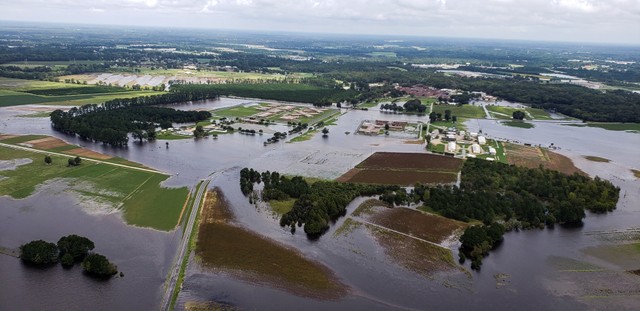CHICAGO (Reuters) – North Carolina estimated on Tuesday that 3.4 million poultry birds and 5,500 hogs died in Hurricane Florence, exceeding the number killed in the state’s last major hurricane two years ago.
The North Carolina Department of Agriculture and Consumer Services projected the animal death toll after emergency workers and veterinarians spent days in the field assessing losses at farms following the storm.
“I’m just assuming, based on the depth of the water that we had in North Carolina and the amount of rainfall, that we probably will exceed what we had in [Hurricane] Matthew,” Agriculture Commissioner Steve Troxler said in an interview, referring to hog losses. He spoke on Tuesday after flying over flooded areas, before the department issued its estimates.
North Carolina has 8.9 million swine, representing 12 percent of the U.S. herd, according to the U.S. Agriculture Department (USDA). Raised in barns, they can become trapped and drown in floods.
Last year, North Carolina farmers also raised 830.8 million chickens for meat, 9 percent of the U.S. flock, and 32.5 million turkeys, or 13 percent of the U.S. total, according to the USDA.
Troxler said 2,800 hogs and 1.8 million birds died from Hurricane Matthew.
“There are going to be some pretty good losses on the poultry side judging from the flooded houses that we saw,” Troxler said.
North Carolina is the country’s No. 2 swine-producing state, its leading producer of tobacco and a major poultry producer, making agriculture its principle industry, valued at $87 billion.
Hurricane Florence, which came ashore last Friday with torrential rains, has caused more outdoor hog manure pits to collapse and overflow in North Carolina than Hurricane Matthew did in 2016, according to state data, stoking concern about possible water contamination.
The deaths of 26 people in North Carolina and six in South Carolina have been attributed to the storm.
High winds and flooding damaged two chicken farms that supply Tyson Foods Inc
WH Group Ltd’s Smithfield Foods Inc [SFIL.UL], the biggest U.S. pork producer, was operating processing plants at limited capacity, after previously closing the world’s largest hog slaughterhouse in Tar Heel, North Carolina, spokeswoman Diana Souder said. Flood waters inundated the barns and waste pit at one company-owned hog farm in the state, she said.
North Carolina’s Department of Environmental Quality said on Tuesday that the walls of four pits holding hog waste, known as lagoons, had given way because of the storm, thirteen pits had overflowed due to rain, and nine were inundated by floodwaters.
Hurricane Matthew caused a partial structural failure at one lagoon, while none overflowed from rain and 14 were inundated by floodwaters, according to the industry group NC Pork Council.
More lagoons were at risk of overflowing in the days ahead, state data showed, including 30 that are filled to the brim with waste and water, and another 25 with zero to three inches of space to spare.
There are more than 3,300 lagoons in North Carolina, said Andy Curliss, chief executive for the NC Pork Council.
Hog producers, including Smithfield, lowered the levels of waste in lagoons before the storm, but up to 36 inches (91 cm) of rain overwhelmed some farms.
Matt Wellington, antibiotics program director of U.S. PIRG, a federation of public interest groups, said the release of waste from lagoons could spread antibiotic-resistant bacteria. Farmers raise hogs with antibiotics, which can be found in their waste, he said.
Sampling waterways in eastern North Carolina after Hurricane Matthew showed a temporary increase in concentrations of some bacteria and pollutants in spots, according to a 2017 report from the state’s Department of Environmental Quality.


